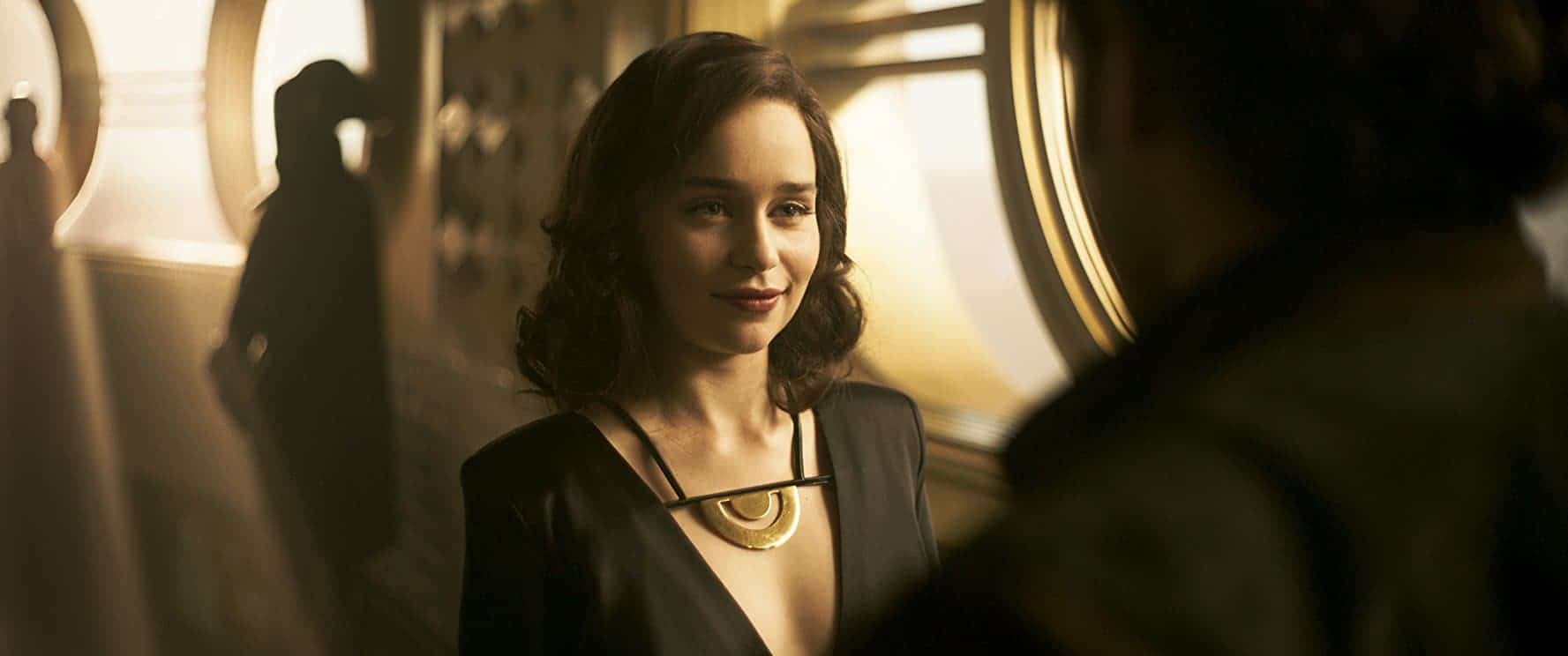
Doesn’t Qi’ra remind you of someone?
Star Wars has a type. She’s twenty-something, pale, brunette, and as of the 2012 Disney purchase, British. Since Disney took the helm, women not matching this specific profile have been allowed to take secondary roles — Rose Tico (Kelly Marie Tran) in The Last Jedi, the terrible wastes of Gwendoline Christie and Thandie Newton that are Captain Phasma and Val, respectively. But front and center, the pattern continues with remarkable consistency: Leia (Carrie Fisher) and Padmé (Natalie Portman) and Rey (Daisy Ridley) and Jyn (Felicity Jones) and now, with the release of Solo: A Star Wars Story, Qi’ra (Emilia Clarke).
In terms of representation, the issue this presents is obvious — and one that has been widely discussed, both as a general issue within the film industry and in various specific contexts. The unfortunate repetitiveness of spotlighting the same kind of character time and time again when this galaxy far, far away is supposedly full of humans of all ages, shapes, sizes, and colors (not to mention aliens) is quite self-evident, so I’m not going to be needlessly repetitive myself.
Instead, let’s talk about some unfortunate and entirely avoidable subtext that Star Wars’ sticking so closely to their preferred female paradigm has created.
The term “needless repetition” is particularly relevant in discussing Solo because that is the film’s general problem in a nutshell. Between the original trilogy and The Force Awakens, Han Solo has a satisfying character arc with a decided beginning, middle, and end. Perhaps not every aspect of his life was laid bare in biography-level detail, but no burning questions were left behind.
Solo isn’t a total disaster, but the lone big question most viewers have going into Solo –“is there an actual point to this movie?” — has the unfortunate answer of “no, not really” (besides the usual corporate greed).
The film doesn’t give any shining new insight into the mind of Han Solo. Alden Ehrenreich’s generally fine but weirdly low-affect performance serves the primary function of making one nostalgic for a young Han Solo played by young Harrison Ford, the way it should be. It might be better than going the Rogue One zombie Tarkin route of CGI-ing Peter Cushing, but that is a very low bar to clear. Meanwhile, Donald Glover as Lando Calrissian confirms that we’d all be much happier if Solo was Lando, because the story of how a gambler becomes Administrator of Cloud City sounds like a far more intriguing tale then how a smuggler ends up in a cantina on Tatooine. So, in sum: Solo is mildly entertaining, largely redundant, and full of needless backstory.
But one key participant in this needless backstory is Qi’ra, Han Solo’s first love. Within minutes of Qi’ra’s introduction in Solo, we learn a few things:
1) She’s alone in the world, presumably an orphan.
2) She’s scrounging for survival, and her access to food — portions, specifically — is controlled by a miserly and aesthetically unfortunate creature.
3) She gets left behind by the person she cares about most on a garbage dump of a planet, doomed to a life of scavenging for portions (but said person promises to come back).
Her familiarity goes beyond being a twenty-something white, British brunette, like Star Wars heroines before her. While anyone even somewhat familiar with the sequel trilogy should be able to see what I’m getting at here, it’s Qi’ra’s name that seals the deal. There are approximately 10,000 ways to spell the name Qi’ra. There’s Keira, as in Knightley, or Ciara, as in my name — or Kira, as in Rey’s name in early drafts of The Force Awakens.
From her looks to her background to her name, Han Solo’s first love presents clear parallels to Rey — a discovery that adds unavoidable subtext to Han’s relationship with Rey in The Force Awakens. It’s arguably the most significant “revelation” that Solo presents in relation to existing Star Wars films, even though its very existence might have been entirely unintentional; the byproduct of Star Wars favoring a rather specific appearance in female leads (and somewhat unoriginal naming choices).
Before Solo, Han’s relationship with Rey comes across as something like a mentorship—almost paternal, as brief as it ultimately proves to be. It’s compelling and tragic and fits the franchise’s pattern of killing mentors to a T.
Han’s motives for taking the Jakku scavenger under his wing are somewhat unclear. He’s not exactly the sort of character to wax poetic or wear his heart on his sleeve. Maybe he sees it as a second chance to succeed in a fatherly role considering how Kylo Ren turned out —a way of assuaging the guilt he feels over what became of Ben Solo, and things he might have done better. Maybe he sees something of himself in the scrappy survivor from the wastelands of Jakku. Perhaps he’s just getting a little softer in his old age. Perhaps some combination of any or all of the above.
But after Solo, a new potential motive must be acknowledged: Rey reminds him of his first love. Specifically, a woman whom he might still harbor guilt over leaving behind on Corellia all those years ago, much like Rey was left behind by her parents on Jakku.
Such a motivation would hardly turn Han into a villain, but there’s a slimy residue to Han seeing Rey as a ghost of a past romance that contaminates a previously wholesome and entirely innocent dynamic. This contamination could have been avoided without changing Qi’ra’s character arc at all by simply making different casting and naming choices.
When it comes to female protagonists, Star Wars clearly has a type. For the sake of the narrative and all characters involved, it’s high time to move on and diversify.
Related Topics: Solo, Star Wars



